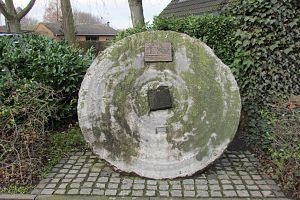Liecker mill
| Liecker mill
|
||
|---|---|---|
|
Millstone of the Liecker mill as a memorial stone |
||
| Location and history | ||
|
|
||
| Coordinates | 51 ° 2 '41 " N , 6 ° 8' 52" E | |
| Location | Germany | |
| Waters | Worm , boy worm | |
| Built | 1808 | |
| Shut down | around 1930 | |
| technology | ||
| use | Grinding mill | |
| Grinder | 1 grind | |
| drive | 1 water wheel | |
| water wheel | undershot | |
The Liecker Mühle was a watermill on the Junge Wurm in the town of Heinsberg in the North Rhine-Westphalian district of Heinsberg in the administrative district of Cologne .
geography
The Liecker mill had its location on the boys worm , at the Sibertstraße, in the district Dremmen in town Heinsberg. The land on which the mill building stood was approx. 46 m above sea level . Above was the valley mill , below was the location of the Schafhausen oil mill .
Waters
The Junge Wurm was a body of water that ran more or less parallel to the Wurm . The junction from the Wurm was in Nirm, a district of the city of Geilenkirchen . Here the worm has a height of 54 m above sea level. The river Junge Wurm, also known as the Kleine Wurm , flowed in a north-northwest direction via Randerath , Horst , Porselen , Dremmen , Grebben , Heinsberg , Kempen and Karken across the German - Dutch border towards Vlodrop and empties at an altitude of 29 m above sea level on Dutch territory into the Rur . It was a natural body of water in which humans had a hand in many places. The Junge Wurm was connected to the Heinsberg moat , the mill canal, the Liecker brook and the mill brook . This composite body of water served for surface drainage and the benefit of the people. For centuries there were around 15 water mills on the Junge Wurm, with a slope of 26 m between Randerath and Karken. With the worm straightening in the 1960s and 1970s, the young worm disappeared from the maps . Instead, drainage channels and trenches were created. The water association Eifel-Rur (WVER) is responsible for the care and maintenance of the water body with a catchment area of 355.518 km 2 .
history
Dremmen was one of the places that was in the restricted area of the Horster mill . The removal of the mill compulsory took place in the French times and so the Liecker mill was not built in Dremmen until 1808. Because of its location on Driesch it was also called Driescher Mühle, or Heitzer Mühle after its owner. Since the mill was only around 700 m away from the valley mill, disputes about the storage rights were often brought to court . Only in 1829 was the dispute of Müller terminated by agreement. The mill continued to work until 1930, when it was shut down and served as a residential building. In 1999 the building was closed and has given way to a new building. The street name Driescher Mühle and a millstone with a plaque remind of the old days.
gallery
Dremmen on the tranchot card 1806/1807
literature
- Hans Vogt: Lower Rhine water mill guide 2nd edition. Verein Niederrhein, Krefeld 1998, ISBN 3-00-002906-0 , pages 307-309.
→ See also the list of mills on the Wurm
Web links
Individual evidence
- ^ German basic map 1: 5000
- ↑ Archived copy ( memento of the original from October 17, 2013 in the Internet Archive ) Info: The archive link was inserted automatically and has not yet been checked. Please check the original and archive link according to the instructions and then remove this notice.
- ↑ http://www.wver.de/






